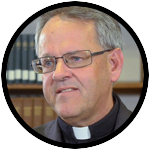
Father Thomas Dailey, O.S.F.S.
In a talk at the headquarters of Facebook, Bishop Robert Barron explained “how to have a religious argument.” He began by postulating that such debate, online or offline, works only when founded on the truth that faith is not opposed to reason.
That principle has long been a staple of Catholic theology and was thoroughly elucidated in St. John Paul II’s encyclical Fides et Ratio, a tour-de-force of magisterial teaching that, when understood, saves modern philosophical thinking from imploding.
But the bishop made his point in simpler terms and with a catchy quote that caught the attention of those denizens of the post and comment domain. There in Silicon Valley, where life is governed through a labyrinth of logarithms, Barron quoted Oliver Wendell Holmes: “I would not give a fig for the simplicity this side of complexity. But I would give my life for the simplicity on the other side of complexity.”
The bishop’s point is that faith is not a simplistic alternative to, or abdication, of rational thinking. On the contrary, it represents a deliberate choice to trust in relation to the God who reveals himself to human beings. Faith as a way of knowing entails not the verifiability of scientific proofs, nor the veracity of philosophical ideas, but the personal certitude that can only be known in and through a friendship.
[hotblock]
Without complexity, faith is simply adherence to some belief; with the complexity of grappling for a response to existential questions and personal anguish, faith becomes a simple trust in God as “the way, the truth, and the life.”
More recently, in his Erasmus Lecture, Bishop Barron expanded on this theme in terms of “evangelizing the nones” (i.e., those claiming to be spiritual without any religious affiliation). He concluded that talk with a call to engage this cohort — now 25 percent of the population — with a radical witness to the faith. For this, he recommends we re-visit and re-present the living treasures of the church.
One of those treasures is eucharistic adoration. It may come as a surprise, but this devotional exercise holds a certain appeal for young adults.
Some attribute their interest to an outdated and unfounded nostalgia for the church of old, others to a cult-like fascination with what is mysterious. But I think there’s more to it.
For the under-30 generation, 40 percent of whom count among the “nones,” the religious impulse has not disappeared altogether. They still hold core religious beliefs, even if they are not well-versed in them. They still seek meaning and purpose in life. They still ask the questions that have always compelled the human heart, as St. John Paul II says: Who am I? Where have I come from and where am I going? Why is there evil? What is there after this life?
For that philosopher-pope, “the answer given to these questions decides the direction which people seek to give to their lives” (Fides et Ratio, no. 1) — even, or especially, for young people.
Adoration can point the way. For this new media generation, answers to the questions they ask are socially shaped. What that means when it comes to religion is that their sense of the sacred goes beyond traditionally holy things (places, objects, etc.) to include their own subjective experience, which, of course, they like to “share” online.
Adoration shapes a combination of both. The traditional element comes with the smells ‘n bells: the candle-lit church, the fragrant incense, the ornamental monstrance and memorable Latin hymns. These draw the human spirit by appealing to our innate wonder about the supernatural. We respond with benediction.
But even with the liturgical rite, personal experience still holds sway. Whether in solitary prayer or lone wonder, adoration offers to seekers young and old an opportunity to be aware of a something (actually, a Someone) greater than the chaos of this world, while at the same time assuring them of a goodness (really, a divine Presence) that perdures in and beyond the challenges of their lives. To “behold Him who takes away the sins of the world” opens oneself to transformation.
Yes, adoration is simple faith, of a kind that we could give a life for. For the faithful, it’s sung at Christmas and prayed before the cross and celebrated with a holy hour or a Forty Hours devotion.
For the young, this living tradition may be one way that they, too, can believe, on the far side of their own complexities.
***
Editor’s note: All are invited to the close of Forty Hours at St. Charles Borromeo Seminary on Friday, Nov. 3 at 7 p.m. The devotion will begin at Immaculate Conception Chapel and after a procession, conclude at St. Martin Chapel. Forty Hours also will be celebrated at St. Charles Borromeo Parish in Drexel Hill Nov. 6-8. Bishop Robert Barron will give the Cardinal Foley Lecture at St. Charles Borromeo Seminary on Jan. 29, 2018.
PREVIOUS: Gratitude is good for you, and it makes you happy
NEXT: A Thanksgiving place setting for those who won’t come home



Science doesn’t have all the answers. Why shouldn’t there be a place for God and spirituality?